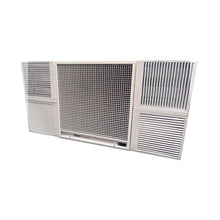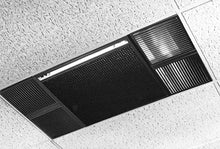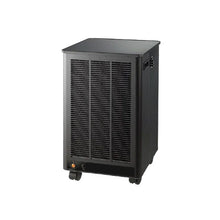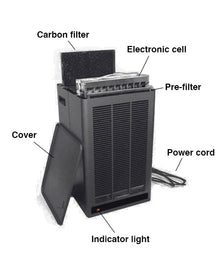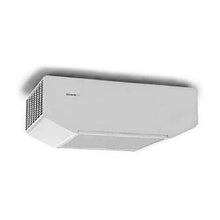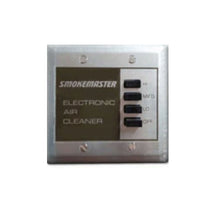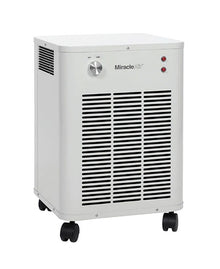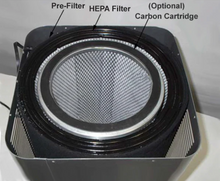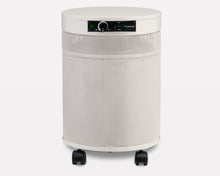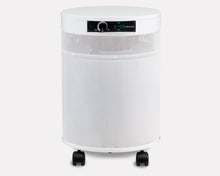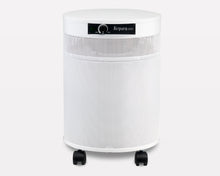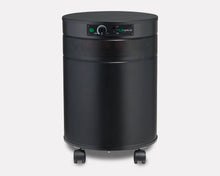The Complete Guide to Air Purification in Large Office Spaces: Why Standard HVAC Isn't Enough
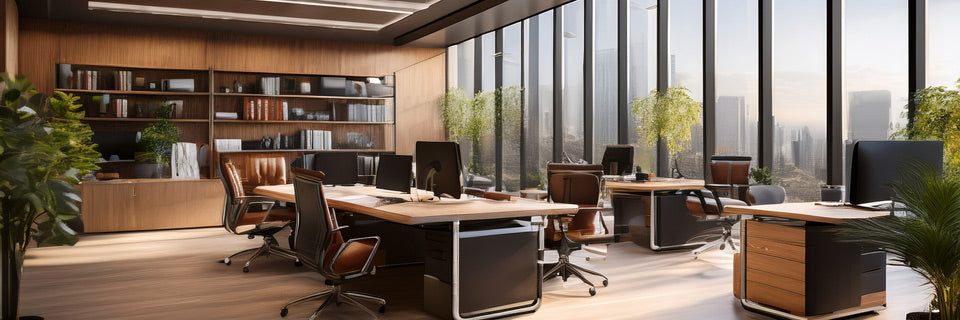
Picture this: It's 2 PM on a Wednesday, and you're sitting in your open-plan office trying to focus on an important presentation. But instead of feeling sharp and energized, you're battling a persistent headache, your eyes feel dry and irritated, and that mental fog just won't lift. You're not alone—and the culprit might be floating right in the air around you.
If you're responsible for workplace health and safety, facilities management, or simply want to understand why office air quality matters so much, you're about to discover the hidden factors that could be impacting your team's health and productivity every single day. More importantly, you'll learn exactly what separates basic air circulation from true air purification, and why this distinction could be the key to creating a healthier, more productive workspace.
The Hidden Crisis in Office Air Quality
The statistics surrounding indoor air quality in commercial buildings paint a concerning picture that many facility managers and business owners are just beginning to understand. People spend approximately 90% of their time in indoor environments, making the quality of office air a critical factor in employee health and wellbeing.
Research reveals that poor indoor air quality in buildings can decrease productivity by as much as 6-9%, representing potentially thousands of dollars in lost productivity per employee annually. But the impact extends far beyond reduced efficiency. Poor indoor air quality has been tied to symptoms like headaches, fatigue, trouble concentrating, and irritation of the eyes, nose, throat and lungs.
The challenge is particularly acute in large office spaces where multiple factors converge to create a perfect storm of air quality issues. Modern office buildings, designed for energy efficiency, often prioritize sealed environments that can trap pollutants inside. Meanwhile, the concentration of people, office equipment, cleaning products, and various building materials creates a complex cocktail of indoor air contaminants.
What makes this crisis particularly insidious is its invisibility. Unlike a water leak or broken air conditioner, poor air quality doesn't announce itself with obvious signs. Instead, it silently affects everyone in the building, contributing to what facility managers often dismiss as routine sick days, afternoon energy crashes, or general workplace complaints.
The financial implications extend beyond productivity losses. Indoor air pollution can cause a range of health issues, including respiratory diseases, heart disease, cognitive deficits, and cancer, potentially leading to increased healthcare costs, higher absenteeism rates, and even legal liability for employers who fail to provide a safe working environment.
Understanding Your Office's Air Pollution Sources
Large office spaces face unique air quality challenges that differ significantly from residential environments. The sheer scale and complexity of these spaces create multiple pollution sources that work together to compromise indoor air quality.
Human-Generated Contaminants represent one of the most significant sources in busy office environments. Every person exhales carbon dioxide, water vapor, and various organic compounds. In a typical open-plan office with 50-100 employees, this biological load can quickly overwhelm standard ventilation systems, especially during peak occupancy hours.
Office Equipment Pollution is often underestimated but critically important. Printers, copiers, computers, and other electronic devices emit ozone, volatile organic compounds (VOCs), and ultrafine particles. Laser printers, in particular, can release particles small enough to penetrate deep into lung tissue. The concentration of this equipment in modern offices creates a continuous source of pollutants throughout the workday.
Building Materials and Furnishings contribute through off-gassing processes that can continue for years after installation. Carpets, furniture, paint, adhesives, and cleaning products release formaldehyde, benzene, and other chemical compounds into the air. In large office spaces, the cumulative effect of these sources can create significant chemical loads.
External Pollution Infiltration occurs when outdoor air pollutants enter the building through ventilation systems, open windows, or structural gaps. Urban offices face particular challenges from vehicle emissions, industrial pollutants, and seasonal allergens that standard HVAC systems may not adequately filter.
Biological Contaminants thrive in the controlled climate of office buildings. Mold spores, bacteria, and dust mites can proliferate in HVAC systems, particularly in areas with moisture issues or inadequate maintenance. These biological pollutants can trigger allergic reactions and respiratory problems, particularly in employees with existing sensitivities.
The concentration effect in large office spaces means that these individual sources compound each other's impact. A single small office might handle moderate levels of each pollutant type, but in large spaces with high occupancy, the cumulative effect can create air quality conditions that significantly impact health and productivity.
HVAC Systems vs. True Air Purification: The Critical Difference
Most facility managers assume their building's HVAC system provides adequate air purification, but this assumption often proves costly. Understanding the fundamental differences between basic air movement and comprehensive air purification is essential for creating truly healthy office environments.
Standard HVAC Limitations become apparent when you examine what these systems are actually designed to do. Traditional HVAC systems focus primarily on temperature control and basic air circulation. For most commercial buildings, filters with a MERV rating between 8 and 13 will sufficiently filter the air, but "sufficient" doesn't mean optimal for health and productivity.
Most standard commercial HVAC systems use MERV 8 filters, which capture particles larger than 3 microns. While this includes dust, pollen, and some mold spores, it misses the most dangerous pollutants: ultrafine particles, volatile organic compounds, and biological contaminants smaller than 1 micron. These tiny particles can penetrate deep into lung tissue and even enter the bloodstream, causing systemic health effects.
The Filtration Gap becomes critical when you consider that many of the most harmful pollutants fall below the threshold of standard HVAC filtration. Virus particles, bacteria, fine particulate matter from office equipment, and chemical vapors pass through basic filters unchanged. Even when buildings upgrade to MERV 13 filters, a filter rated at MERV 13 will remove 90% of particles from 1 to 10 microns in size, but less than 75% of particles smaller than 1 micron.
Air Circulation vs. Air Cleaning represents another fundamental difference. HVAC systems excel at moving air throughout a building and mixing outdoor air with indoor air. However, this circulation can actually spread pollutants more effectively throughout the space if the air isn't properly cleaned first. Without adequate filtration, the HVAC system becomes a distribution network for contaminants rather than a purification system.
Maintenance and Performance Degradation further complicate the situation. HVAC filters lose efficiency as they collect particles, and in many commercial buildings, filter replacement schedules prioritize cost savings over air quality. A dirty or degraded filter not only fails to clean the air effectively but can become a source of pollutants itself as captured contaminants break free or support microbial growth.
Zone-Specific Challenges in large office spaces reveal another limitation of centralized HVAC systems. Different areas of an office building face different pollution loads and air quality challenges. The server room generates heat and ozone, the break room deals with food odors and higher humidity, and conference rooms experience spikes in CO2 and biological contaminants during meetings. A centralized system with uniform filtration cannot address these varying needs effectively.
The Science Behind Effective Commercial Air Purification
Effective air purification in large office spaces requires understanding the multiple layers of contamination and employing targeted technologies to address each type of pollutant. Unlike residential air purifiers that might focus on basic particle removal, commercial-grade air purification systems must handle complex, high-volume contamination patterns.
Multi-Stage Filtration forms the foundation of effective commercial air purification. This approach combines different filtration technologies to capture pollutants across the entire spectrum of sizes and types. Pre-filters capture large particles and protect downstream filters, while HEPA filters remove 99.97% of particles 0.3 microns and larger. Activated carbon stages address volatile organic compounds and odors that pass through particle filters unchanged.
Advanced Filtration Technologies go beyond basic mechanical filtration to address the full spectrum of office pollutants. HEPA filtration, while more expensive than standard filters, provides the thoroughness necessary for health-focused air purification. Unlike MERV 13 filters that capture 90% of particles in the 1-10 micron range, HEPA filters are far more effective than MERV 13 filters, considering the small size of viruses (0.06-0.12 microns).
Chemical and Gas Removal requires specialized approaches since these pollutants pass through even HEPA filters without being captured. Activated carbon beds absorb volatile organic compounds, formaldehyde, and chemical odors. Advanced systems may include specialized media for specific chemicals common in office environments, such as ozone from laser printers or formaldehyde from building materials.
Biological Contaminant Control addresses the living pollutants that can multiply within building systems. UV-C sterilization technology can neutralize bacteria, viruses, and mold spores, preventing them from reproducing and spreading throughout the office. This technology is particularly valuable in large office spaces where biological contamination can spread rapidly through shared air circulation.
Air Exchange and Distribution must be carefully engineered for large spaces to ensure that cleaned air reaches all occupied areas effectively. Commercial air purification systems need sufficient capacity to handle the air volume in large offices while maintaining appropriate air exchange rates. This typically requires much higher clean air delivery rates than residential systems provide.
Real-Time Monitoring and Response capabilities allow modern commercial air purification systems to adjust their operation based on actual air quality conditions. Sensors detect particle counts, chemical levels, and other air quality parameters, automatically increasing filtration capacity when pollution loads spike. This intelligent response ensures consistent air quality even as conditions change throughout the day.
Energy Efficiency Considerations become critical in commercial applications where systems operate continuously. Advanced commercial air purifiers use variable-speed motors, intelligent controls, and efficient filter designs to minimize energy consumption while maintaining high purification performance. This efficiency is essential for the total cost of ownership in large office applications.
Health and Productivity Benefits: The Business Case for Clean Air
The business justification for comprehensive air purification in large office spaces extends far beyond regulatory compliance or employee comfort. Mounting research demonstrates tangible benefits that directly impact the bottom line through improved productivity, reduced healthcare costs, and enhanced employee retention.
Cognitive Performance Enhancement provides one of the most compelling arguments for air purification investment. Studies have shown that improved indoor air quality can enhance cognitive function by 15-20%, with particularly significant improvements in decision-making, information processing, and creative problem-solving. For knowledge workers in large office spaces, this cognitive boost translates directly to improved work quality and faster project completion.
Productivity and Attendance Improvements manifest in multiple ways throughout organizations with superior air quality. Poor indoor air quality can decrease productivity by 6-9%, meaning that addressing air quality issues can potentially increase productivity by similar amounts. This improvement appears across various types of office work, from data entry and analysis to creative tasks and strategic planning.
Reduced sick leave represents another significant benefit. Employees in buildings with comprehensive air purification systems typically experience 30-50% fewer respiratory symptoms and related illnesses. For a 100-person office, this could translate to hundreds of saved sick days annually, representing substantial cost savings in lost productivity and temporary staffing needs.
Long-Term Health Benefits become increasingly important as companies focus on comprehensive employee wellness programs. Cleaner air reduces exposure to pollutants linked to cardiovascular disease, respiratory problems, and other chronic health conditions. While these benefits may take years to fully manifest, they contribute to lower healthcare costs and improved employee satisfaction and retention.
Enhanced Workplace Satisfaction emerges as a significant factor in employee retention and recruitment. Workers in environments with clean, fresh air report higher job satisfaction, less fatigue, and improved overall workplace experience. In competitive job markets, superior air quality can become a differentiating factor in attracting and retaining top talent.
Reduced Facility Maintenance Costs often offset a significant portion of air purification system expenses. Cleaner air means less dust accumulation on surfaces, equipment, and in ductwork. This reduction leads to lower cleaning costs, extended equipment life, and reduced HVAC maintenance requirements.
Risk Management and Liability Protection provide additional business value. Companies that proactively address indoor air quality demonstrate due diligence in employee health and safety, potentially reducing liability exposure. This protection becomes particularly valuable in litigation-conscious environments where workplace health issues could result in significant legal costs.
Implementing Effective Air Purification Solutions
Creating an effective air purification strategy for large office spaces requires careful planning, appropriate technology selection, and ongoing management to ensure optimal performance. The complexity of these environments demands a systematic approach that addresses both immediate air quality concerns and long-term maintenance requirements.
Assessment and Planning must begin with a comprehensive evaluation of the existing space and current air quality conditions. Professional air quality testing can identify specific pollutants, measure baseline conditions, and pinpoint problem areas that require focused attention. This assessment should consider occupancy patterns, equipment locations, outdoor air quality, and existing HVAC capabilities.
The assessment phase should also evaluate the building's current filtration infrastructure to determine whether upgrades to existing systems are feasible or whether supplemental air purification systems are necessary. Many large office spaces benefit from a hybrid approach that upgrades HVAC filtration while adding targeted air purification in high-occupancy or high-pollution areas.
Technology Selection must match the specific needs identified during the assessment phase. Large office spaces typically require commercial-grade systems with high clean air delivery rates and the capacity to handle continuous operation. Key considerations include the types of pollutants present, the volume of air that needs treatment, and the available space for equipment installation.
For spaces with significant chemical pollutants from office equipment or building materials, systems with substantial activated carbon capacity become essential. Areas with high biological contamination risk may benefit from UV-C sterilization technology. The selection process should also consider noise levels, energy consumption, and maintenance requirements.
Strategic Placement and Zone Management optimize system effectiveness while minimizing equipment requirements. High-traffic areas like lobbies, conference rooms, and break rooms often benefit from dedicated air purification units. Open office areas may require multiple units strategically placed to ensure adequate coverage without creating air circulation dead zones.
Consider the specific challenges of different office zones when planning purification strategies. Server rooms need ozone removal capabilities, while kitchen and break areas require enhanced odor and humidity control. Meeting rooms benefit from systems that can handle periodic spikes in occupancy and CO2 levels.
Integration with Existing Systems ensures that new air purification technology works harmoniously with current HVAC infrastructure. This integration might involve upgrading central system filters, adding in-duct purification technology, or implementing standalone units that complement existing air circulation patterns.
Proper integration also includes establishing monitoring and control systems that allow facility managers to track air quality improvements and adjust system operation based on changing conditions. Smart building integration can automate responses to air quality changes and optimize energy consumption.
Maintenance and Performance Monitoring are critical for long-term success. Commercial air purification systems require regular filter changes, system cleaning, and performance verification to maintain effectiveness. Establishing clear maintenance schedules and working with qualified service providers ensures consistent performance and maximizes system lifespan.
Performance monitoring should include regular air quality testing to verify that systems are achieving their intended goals. This monitoring can identify developing problems before they compromise air quality and provide data to justify system investments to building owners and management.
Making the Investment: Cost Considerations and ROI
The financial aspects of implementing comprehensive air purification in large office spaces require careful analysis that considers both upfront costs and ongoing operational expenses against quantifiable benefits and long-term value creation.
Initial Investment Components include equipment costs, installation expenses, and any necessary modifications to existing HVAC systems. Commercial-grade air purification systems for large offices typically range from $10,000 to $50,000 depending on coverage area, technology selection, and integration requirements. While this represents a significant upfront investment, the cost per employee served often falls between $200-800, comparable to other workplace health and productivity investments.
Installation costs can vary significantly based on the complexity of integration with existing systems. Standalone units require minimal installation investment, while integrated systems that modify ductwork or control systems may require additional engineering and construction expenses.
Operational Costs include energy consumption, filter replacements, and regular maintenance. Energy costs for commercial air purification systems typically add $0.50-2.00 per square foot annually, depending on system efficiency and operating schedules. Filter replacement costs vary based on usage intensity and local air quality conditions, typically ranging from $500-2,000 annually per system.
Professional maintenance services ensure optimal performance and typically cost $1,000-3,000 annually per system. While these ongoing costs are significant, they're often offset by reduced HVAC maintenance requirements and extended equipment life in cleaner air environments.
Quantifiable Benefits provide clear return on investment calculations. Productivity improvements of 6-9% in a 100-person office with average salaries of $60,000 translate to $360,000-540,000 in annual productivity gains. Even capturing a fraction of this potential improvement can justify air purification investments within the first year.
Reduced sick leave expenses provide additional quantifiable benefits. If air quality improvements reduce sick days by just 2 days per employee annually, the savings in lost productivity and temporary staffing costs can reach $20,000-40,000 annually in a 100-person office.
Less Tangible but Valuable Benefits include improved employee satisfaction, enhanced recruitment capabilities, and reduced legal liability exposure. While these benefits are harder to quantify precisely, they contribute significantly to long-term organizational success and should factor into investment decisions.
Energy savings from reduced HVAC load can also offset operational costs. Clean air requires less mechanical processing, and efficient air purification systems can reduce overall building energy consumption by optimizing air circulation patterns.
Frequently Asked Questions About Office Air Purification
How do I know if my office needs air purification beyond standard HVAC? Signs include employee complaints about headaches, fatigue, or respiratory symptoms, visible dust accumulation despite regular cleaning, lingering odors from office equipment or cleaning products, and high absenteeism rates due to respiratory illnesses. Professional air quality testing can provide definitive answers about pollutant levels and types.
What's the difference between upgrading HVAC filters and adding dedicated air purifiers? Upgrading HVAC filters improves baseline air quality throughout the building but may be limited by system capacity and filter space constraints. Dedicated air purifiers provide targeted, high-efficiency cleaning for specific areas and can address pollutants that pass through even upgraded HVAC filters.
How much maintenance do commercial air purification systems require? Most systems require filter changes every 3-12 months depending on usage and local air quality conditions. Professional maintenance should occur annually to ensure optimal performance. Many systems include monitoring features that alert users when maintenance is needed.
Can air purification systems handle odors from office equipment and cleaning products? Yes, but this requires systems with activated carbon filtration stages specifically designed for chemical and odor removal. Basic particle filters alone cannot address these types of pollutants.
What size system do I need for my office space? System sizing depends on room volume, occupancy levels, and specific air quality challenges. Professional assessment can determine appropriate clean air delivery rates and system capacity. As a general guideline, look for systems that can process the room's air volume 4-6 times per hour.
Will air purification systems be too noisy for office environments? Commercial-grade systems designed for office use typically operate at noise levels comparable to standard HVAC systems (40-50 decibels). Many include variable speed controls that allow quieter operation during noise-sensitive periods.
Creating Healthier Workspaces: Your Next Steps
The evidence is clear: comprehensive air purification in large office spaces represents both a critical health investment and a strategic business advantage. The difference between basic HVAC air circulation and true air purification can mean the difference between a workplace that merely functions and one that actively supports employee health, productivity, and satisfaction.
As you consider your next steps, remember that air quality improvements deliver benefits immediately and compound over time. The cognitive performance enhancements, reduced sick leave, and improved employee satisfaction that result from cleaner air begin within weeks of implementation and continue to grow as employees experience the long-term benefits of healthier indoor environments.
Start with a professional air quality assessment to understand your specific challenges and opportunities. This investment in understanding your current conditions will guide technology selection and ensure that your air purification strategy addresses the most significant issues first.
Whether you're managing a single large office or multiple commercial spaces, the principles remain the same: understand your pollutant sources, select appropriate technology, implement strategically, and maintain consistently. The result will be a workspace that not only meets basic comfort requirements but actively contributes to the health, productivity, and success of everyone who works there.
The question isn't whether you can afford to invest in comprehensive air purification—it's whether you can afford not to. In an increasingly competitive business environment where employee health and productivity provide critical advantages, clean air isn't a luxury—it's a necessity.
About the Author: This guide was developed through extensive research of peer-reviewed studies, industry reports, and best practices from commercial air quality professionals. Information was compiled from authoritative sources including the EPA, OSHA, and leading indoor air quality research institutions.
Sources:
- Indoor Air Quality in Buildings: A Comprehensive Review - PMC (https://pmc.ncbi.nlm.nih.gov/articles/PMC8004912/)
- The effects of indoor air quality on performance and productivity - PubMed (https://pubmed.ncbi.nlm.nih.gov/15330777/)
- Indoor Air Quality - OSHA (https://www.osha.gov/indoor-air-quality)
Published: May 30, 2025

